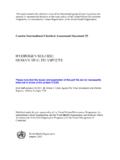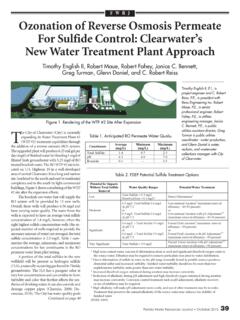Transcription of HEALTH AND SAFETY MANUAL - reagansafety.com
1 1 Purpose/Scope: The purpose of this program is to establish minimum requirements for site specific H2S SAFETY , which will enhance SAFETY in the occupational setting where hydrogen sulfide is present or is recognized as being potentially present. This program sets forth accepted practices for hydrogen sulfide (H2S). This program applies to all employees of the Company, temporary employees, and any contractors working for the Company. When work is performed on a non-owned or operated site, the operator s program shall take precedence, however, this document covers Company employees and contractors and shall be used on owned premises, or when an operator s program doesn t exist or is less stringent. 2 Definitions / Responsibilities: Definitions: Acute Exposure - generally, exposure to a substance for less than 24 hours.
2 Chronic Exposure - generally, exposure to a substance for a period of more than 3 months. Chronic toxicity tests are performed to assess the cumulative toxicity effects and carcinogenicity of chemicals. Contingency Plan - a site-specific written document that provides an organized plan for alerting and protecting the public within an area of exposure following the accidental release of all potentially hazardous atmospheric concentrations of hydrogen sulfide . Exposure Level - permissible exposure level of hydrogen sulfide is 10 ppm for an 8-hour, time weighted average. Gas Detector Instrument - An instrument/detector to measure levels of H2S. Instruments may be electronically or manually operated. hydrogen sulfide (H2S) - is an extremely deadly, toxic gas that in its pure state is colorless and is heavier than air.
3 HEALTH AND SAFETY MANUAL Title: hydrogen sulfide (H2S) SAFETY Approved by: Greg Savoy Rev. 4/1/08 It is the second most toxic gas known to man, ranking behind hydrogen cyanide and ahead of carbon monoxide. It has the odor of rotten eggs at extremely low concentrations, less than 2 ppm. Higher concentrations rapidly paralyze the olfactory nerves (sense of smell). It is also soluable in water, flammable, and poses a definite threat of explosion if not handled properly. Parts Per Million (ppm) - parts of vapor or gas per million parts of contaminated air by volume. Personal H2S Monitor - An electronic instrument worn on the person that is set to alarm at 10 ppm of H2S. Venting - the process of discharging a material to the atmosphere through a series piping and/or venting devices, to facilitate the proper and safe dispersion of toxic materials and to minimize personnel exposure.
4 Responsibilities: Managers/Supervisors are responsible: For ensuring that all employees who are assigned to work at locations where hydrogen sulfide is known to be present, or suspected to be present in any concentration, have been trained in hydrogen sulfide SAFETY within the last 12 months. NOTE: If employees do not regularly work in H2S environments training, including fit testing, shall be completed immediately prior to beginning work. The training and equipment required shall be provided by a competent third party. To ensure employees have been trained in Cardiopulmonary Resuscitation (CPR) and First Aid. To ensure employees have been medically approved to wear respirators and trained on the safe use of respirators, including a respirator fit test in accordance with the Company s Respiratory Protection Program.
5 To ensure employees have been trained and familiar with personal H2S monitors and gas detection instruments. To have been provided with the client's SAFETY procedures. To ensure the necessary respiratory equipment to perform the work safely is available. That each employee has been provided with a copy of this program. Employees are responsible to comply with this program. 3 Requirements: Each person entering a H2S location, regardless of the concentration, shall wear a personal H2S monitor that is set to alarm at 10 ppm. Possible locations where employees may be exposed to H2S during their job functions include: 1. drilling operations 2. water from sour crude wells 3. blowouts 4. tang gauging (tanks at producing, pipeline and refining operations) 5. field maintenance at tank batteries, wells, compressor equipment, etc.
6 When work requires opening any equipment on location that has the potential of releasing concentrations of H2S, between 10 and 99 ppm, a single worker is allowed. That person shall wear either a self-contained breathing apparatus (SCBA) or an airline supplied respirator equipped with a 5-minute escape pack. After the equipment has been opened and the H2S concentration has been cleared to below 10 ppm, the breathing equipment is no longer required, except for possession of a 5-minute escape pack by each employee. When work requires opening any equipment on location that has the potential of releasing concentrations of H2S at 100 ppm or higher, two or more H2S trained persons shall be present and follow these procedures prior to and during the opening of the equipment: Each person entering the H2S location shall don a personal H2S monitor prior to entry.
7 A tailgate meeting will be held with everyone on location to discuss the work plan, the responsibilities of each person and the emergency rescue plan. NOTE: If employees do not regularly work in H2S environments training, including fit testing, shall be completed immediately prior to beginning work. The training and equipment required shall be provided by a competent third party. Each person shall have either a self contained breathing apparatus (SCBA) or a supplied airline respirator equipped with a 5-minute escape pack, and shall be worn when opening the equipment to the surrounding atmosphere. At least one person (per two workers), equipped with a SCBA will act as a stand-by person and may not participate in the work being performed until the atmosphere has been tested and found to have no H2S present in quantities over 10 ppm.
8 The stand-by person shall be stationed up wind, within 100 feet and in clear view of the workers. If an operator or other third party provides the stand-by person, it will be the responsibility of the Company manager/supervisor in charge to verify that the person has been H2S, CPR, and First Aid trained, and that they have provided their own respiratory equipment. Only Company employees may wear Company respirator equipment. If Reagan Power & Compression employees will use client or other third party equipment, the equipment must be inspected to ensure it is safe to use and meets the Company s requirements. After the equipment has been locked and tagged out, opened and the H2S concentration has been cleared to less than 10 ppm, the stand-by person will no longer be required. Work may then be performed without respiratory equipment, except for the required 5-minute escape pack.
9 Safe work procedures: Maintain compliance with permit requirements of the Company and any requirements by the client. Verify that proper SAFETY equipment is available, functioning properly and is utilized. Check and remain aware of wind conditions and direction. Perform a through check of the downwind area prior to the start of any potentially hazardous work activity. Check for other personnel and ignition sources. Ventilate work areas by venting and purging lines and vessels prior to beginning any work activities. Keep all non-essential personnel away from work areas. If H2S monitor alarm is sounded, personnel will vacate the area immediately. Equipment: The following equipment shall be provided and used as required by this program: Personal H2S monitor set to alarm at 10 ppm.
10 Portable H2S gas testing instrument, either electronic or MANUAL pump operated, capable of testing the suspected concentrations of H2S in the system. Each testing instrument must be capable of testing the suspected concentrations of H2S by using the manufacturer s recommended calibrated tube or other means of measuring the concentration of gas. Testing instruments shall be calibrated periodically according to the manufacturer s recommendation, and at least annually. Calibration kits with regulator for calibrating the personal monitor. Calibration gas cylinder for testing the personal monitor. 5-minute escape pack. Full face, air supplied, positive pressure hose line respirator, with 5 minute escape pack attached, or; A self-contained breathing apparatus (SCBA) (air pack) with a minimum of a 30-minute air supply.







